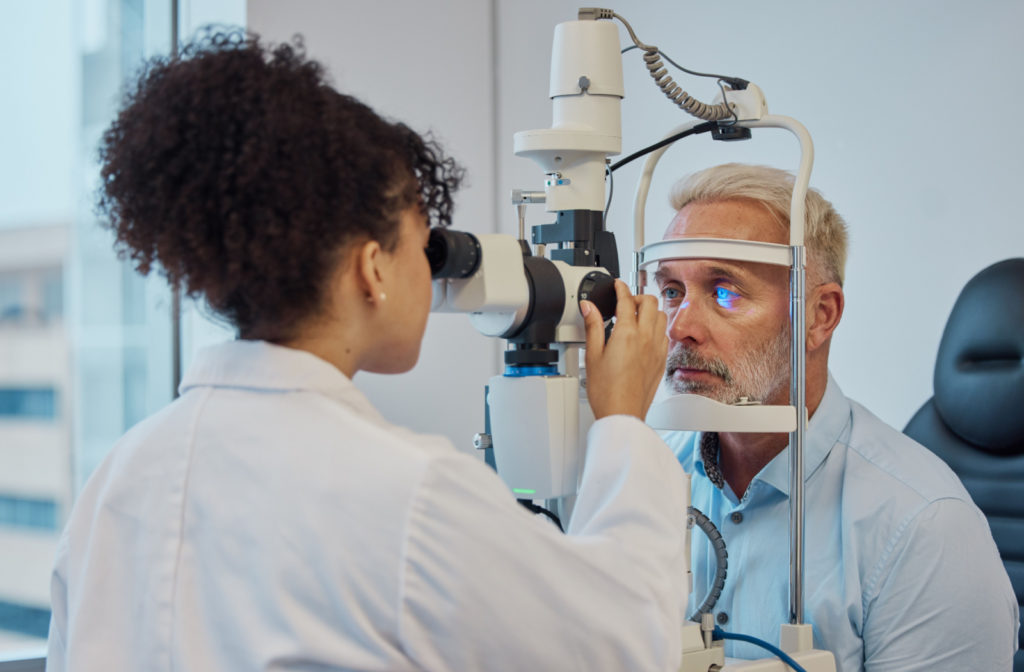As an adult, you should visit your optometrist at least once a year for a regular checkup. This gives a trained eye care professional the chance to thoroughly examine your eyes. But it isn’t just about your vision—eye exams give an optometrist a way to determine if you’re developing an eye disease or health condition that may not otherwise be noticed.
In fact, there are many diseases that can be detected during an eye exam, including:
- Cataracts
- Glaucoma
- Conjunctivitis
- Macular degeneration
- Diabetic retinopathy

1. Cataracts
Cataracts develop when the eye’s normally clear lens begins to become cloudy. Think of it like you’re trying to look through a window that’s mostly fogged over. In most cases, these develop due to age-related changes in the eye, but you’re more likely to develop a cataract if you smoke or frequently expose your eyes to direct sunlight.
Cataracts often cause:
- Decreased ability to distinguish between colors
- Light sensitivity
- Poor night vision
- Halos around light sources
Cataracts are a common eye condition, and they’re easy to fix through a simple cataract surgery. In fact, they’re so common that cataract surgery is one of the most commonly performed operations in the country.
2. Glaucoma
Glaucoma is a group of eye conditions that damage the optic nerve, typically due to high eye pressure. It often develops from a buildup of fluid in the front part of the eye.
There are several different types of glaucoma:
- Open-angle glaucoma, which is the most common type, causes the drainage canals in your eye to become blocked or impacted in some way. This leads to a buildup of pressure inside the eye.
- Secondary glaucoma develops as a result of another medical condition.
- Angle-closure glaucoma occurs when the edge of the iris stops fluid from draining out of the eye.
- Congenital glaucoma, which is present from birth, is extremely rare and affects less than 1 in 10,000 babies.
Angle-closure glaucoma is considered a serious medical condition. Once fluid stops draining from the eye, the intraocular pressure builds quickly. If it’s not treated, this can cause long-term vision problems or even blindness in a matter of days. If you notice severe eye pain accompanied by deteriorating vision, seek medical attention.
3. Conjunctivitis
Conjunctivitis, more commonly known as pink eye, refers to inflammation or infection of the conjunctiva—the thin membrane of the eyelid and outside of the eyeball.
Pink eye can be caused by:
- Allergies: If you have allergic conjunctivitis, you can take antihistamines, and it’ll subside quickly. This form isn’t contagious.
- Bacterial infection: If you have bacterial conjunctivitis, you should visit your optometrist or healthcare provider to get antibiotics. This form is contagious and can be spread through most infected surfaces.
- Virus or airborne pathogens: If you have viral conjunctivitis, you should see your optometrist for care. Typically, this form goes away on its own within a week or so, but an eye doctor may be able to help find you relief from symptoms sooner. Viral conjunctivitis is considered highly contagious.
During an eye exam, your optometrist will keep an eye out for signs of inflammation or discomfort, so they may be able to detect pink eye early.
4. Macular Degeneration
Macular degeneration, also called age-related macular degeneration or AMD, is a common eye disease that typically affects people over the age of 50. It damages the macula—the part of the retina responsible for sharp, clear, central vision—and can cause a dark or empty spot to appear in your central vision.
The exact cause of this condition isn’t known, but since it typically develops with age, it’s believed to be caused by age-related changes in the eye. There are two types of AMD:
- Dry AMD, which is more common. In this type, cells in the retina slowly break down over time.
- Wet AMD, which is more severe but much more rare. With wet AMD, new blood vessels develop in and under the retina. These can leak and cause scarring, making it much more serious.
Since treatments for AMD vary depending on the type, it’s crucial to receive a proper diagnosis to determine what type of AMD you’re experiencing.
5. Diabetic Retinopathy
Diabetes affects many parts of your body—but did you know it can also affect the eyes and cause a condition called diabetic retinopathy?
This condition develops when high blood sugar levels damage blood vessels in the retina and start to affect your vision. In later or more severe cases of diabetic retinopathy, new blood vessels start to grow and leak fluid into the eye. This condition can be managed to an extent by monitoring blood sugar levels and working closely with an optometrist.
Annual diabetic eye exams can help people with diabetes maintain their eye health and reduce the risk of diabetic retinopathy.
The Importance of Eye Exams
Annual eye exams aren’t something to brush off. They’re crucial for taking care of your eyes and spotting potential health concerns that may not show signs on the surface. With early detection, many eye diseases and conditions are treatable.
Your eyes are important, and our team at Total Vision Del Mar is here to help. So, why wait? Book an appointment with us today.



